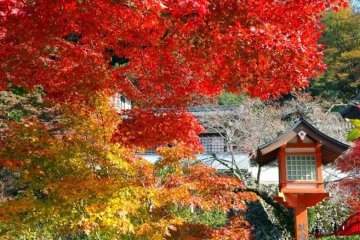
Minoo Park
Minoo Park, also referred to as Mino or Minoh, is a forested area on the outskirts of Osaka that provides residents and visitors alike a peaceful haven among nature. The scenic valley was given quasi-national park status in 1967 and is popular for its maple trees, well-maintained walking paths, quaint shops and restaurants, temples, and, most famously, for the stunning Minoo Waterfall. Take a break from fast-paced city life and start a rejuvenating journey along Minoo Park’s most popular walking path. This three-kilometer trail begins near Hankyu Minoo Station and ends at Minoo Waterfall with a walking time of about 45 minutes to one hour (one way). The path’s well-paved roads and lack of major inclines make it a wonderful place for a relaxing stroll. For the first half of the trail, enjoy a flat walk among traditional homes, shops, restaurants, and enchanting forest scenery. While hiking, keep an eye out for wildlife, including monkeys and deer! Ryuanji Temple marks the midpoint between the station and the waterfall and is a frequent stop for visitors. The seventh-century temple grounds are located to the right of a vibrant vermillion bridge and play host to scenic cherry blossoms in the spring and brilliant red foliage in autumn. Another notable destination along the trail is the Minoo Park Insect Pavillion, which features over 6,000 types of Japanese insects that are sure to satisfy your environmental curiosity. The second half of the trail is more steep and isolated among the trees. At the end of your journey, you will reach your destination—Minoo Waterfall. This 33-meter tall waterfall is the park’s main attraction and has been used as a meditation site since the sixth century. Sit on one of the many benches near the falls, watch the rushing waters, and lose yourself to the calming sound of water. The most popular time to visit Minoo Park is during autumn, specifically late November, when the park’s foliage changes color and the many maple trees turn bright red. During this seasonal celebration, the park’s shops sell tasty momiji tempura, which are maple leaves fried in batter. The unique snack is both sweet and salty with a crunchy exterior. Be sure to try the one-of-a-kind treat and pick some up as souvenirs. For more secluded nature paths, explore hiking trails that extend off the main path into the surrounding hills. Maps are available at the beginning of the trail.


/135.53236484528,34.808200920758,9/397x132?access_token=pk.eyJ1IjoiamFwYW50cmF2ZWxtYXBzIiwiYSI6ImNqbXBtOXYxbDB5Z3ozbHFrazJuYWMwOGYifQ.v15fy_mcFWtgopmz8PhwqA)

